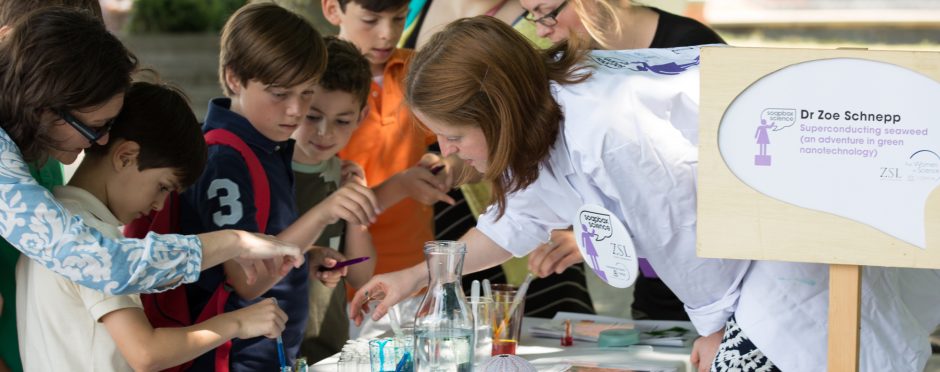 Morag Taite is an Irish Research Council funded PhD student working with Dr Louise Allcock on cephalopod evolution at the National University of Ireland Galway. She will be taking part in Soapbox Science Galway on 7th July with her talk: “The evolution of octopuses and their relatives from ancient to present day oceans”
Morag Taite is an Irish Research Council funded PhD student working with Dr Louise Allcock on cephalopod evolution at the National University of Ireland Galway. She will be taking part in Soapbox Science Galway on 7th July with her talk: “The evolution of octopuses and their relatives from ancient to present day oceans”
By Morag Taite
Now I know what most of you are thinking, what in the world are cephalopods!?
 Cephalopods are a class of marine molluscs that include species more commonly known as octopuses, squids and cuttlefishes. Cephalopods evolved during the Cambrian Period (around 530 million years ago) and were once one of the dominant life forms in the world’s oceans. However, these cephalopods are not like the ones we know and love today. Ancient cephalopods had external conical shells. The modern cephalopods that most people would recognise today, the octopuses, the squids and the cuttlefishes are not found in the fossil record until at least the Cretaceous period (around 145 million years ago). (photo: Fossilised conical Belemnite shell)
Cephalopods are a class of marine molluscs that include species more commonly known as octopuses, squids and cuttlefishes. Cephalopods evolved during the Cambrian Period (around 530 million years ago) and were once one of the dominant life forms in the world’s oceans. However, these cephalopods are not like the ones we know and love today. Ancient cephalopods had external conical shells. The modern cephalopods that most people would recognise today, the octopuses, the squids and the cuttlefishes are not found in the fossil record until at least the Cretaceous period (around 145 million years ago). (photo: Fossilised conical Belemnite shell)
 Modern cephalopods inhabit all areas of the world’s oceans, however, certain groups tend to inhabit particular areas. Octopuses tend to be found on the sea floor, although there are octopuses that live in midwater areas, squids are found in midwater areas and cuttlefishes in coastal areas. Cephalopods are extremely flexible in body shape and lifestyle. They have diversified hugely into different forms which allow them to live in such diverse habitats. (photo: Cuttlefish)
Modern cephalopods inhabit all areas of the world’s oceans, however, certain groups tend to inhabit particular areas. Octopuses tend to be found on the sea floor, although there are octopuses that live in midwater areas, squids are found in midwater areas and cuttlefishes in coastal areas. Cephalopods are extremely flexible in body shape and lifestyle. They have diversified hugely into different forms which allow them to live in such diverse habitats. (photo: Cuttlefish)
So why did I choose to study cephalopods?
My fascination with cephalopods began while I was working on the IUCN red list of endangered species for Dr Louise Allcock in the National University of Ireland, Galway. The IUCN red list is the world’s most comprehensive inventory of the global conservation status of biological species. This work involved extensive research of each species, inputting the information into the IUCN website and analysing the information to judge the appropriate red list category. It is a scientifically rigorous approach that determines the threat of extinction to all species. This work has a major influence on conservation as the IUCN Red List of Threatened Species plays a prominent role in guiding the conservation activities of many groups such as governments and scientific institutions. It provided me with an invaluable insight into cephalopods of the world, including their ecology, population structure and also their threats.


(IUCN Categories)
And what exactly am I studying?
 My current research is focussed on cephalopod evolution. Several groups of the 800 living cephalopod species have diversified due to their rapid response to drivers of evolution and different adaption strategies. My project aims to study the evolutionary diversifications of such groups eg dumbo octopuses and bobtail squids. The groups I have chosen inhabit different habitats, therefore, will have responded to different environmental pressures. I aim to study the evolutionary history of these groups and how these relationships have changed over time. Why is this important? My work is important as it will assist with the understanding and prediction of how species will respond to future environmental pressures and will contribute to improving the cephalopod tree of life. (Photo: Dumbo Octopus)
My current research is focussed on cephalopod evolution. Several groups of the 800 living cephalopod species have diversified due to their rapid response to drivers of evolution and different adaption strategies. My project aims to study the evolutionary diversifications of such groups eg dumbo octopuses and bobtail squids. The groups I have chosen inhabit different habitats, therefore, will have responded to different environmental pressures. I aim to study the evolutionary history of these groups and how these relationships have changed over time. Why is this important? My work is important as it will assist with the understanding and prediction of how species will respond to future environmental pressures and will contribute to improving the cephalopod tree of life. (Photo: Dumbo Octopus)
